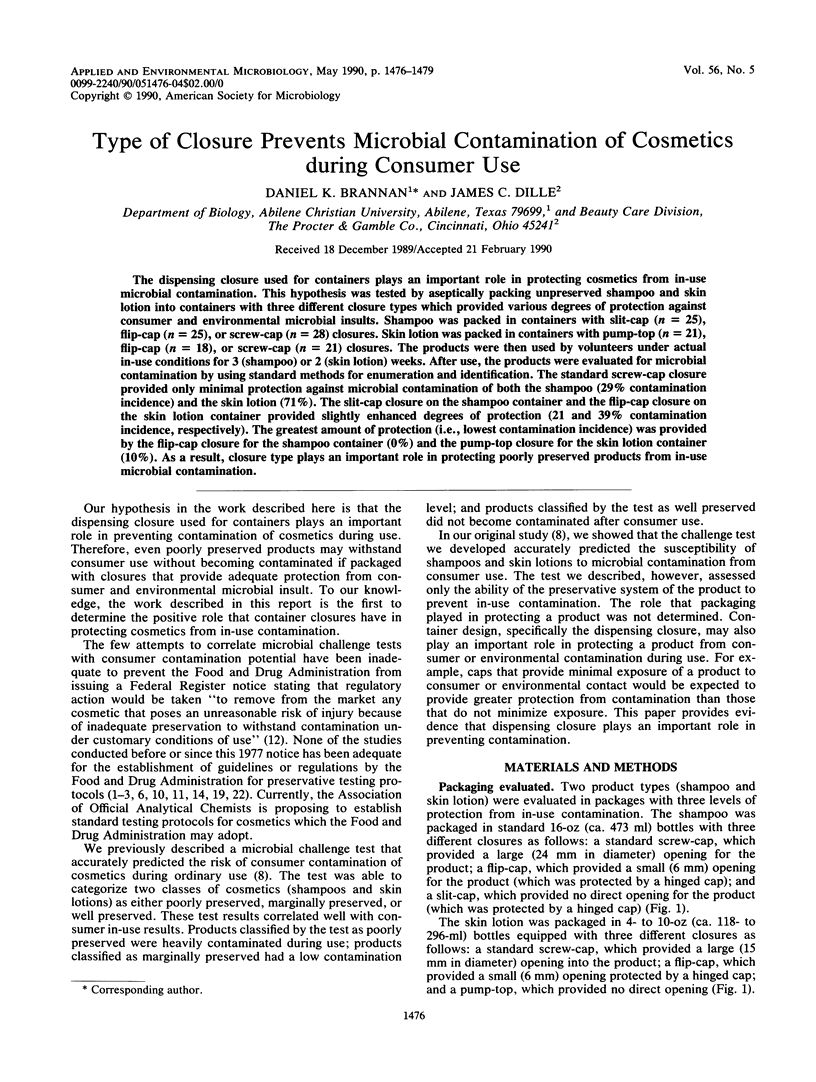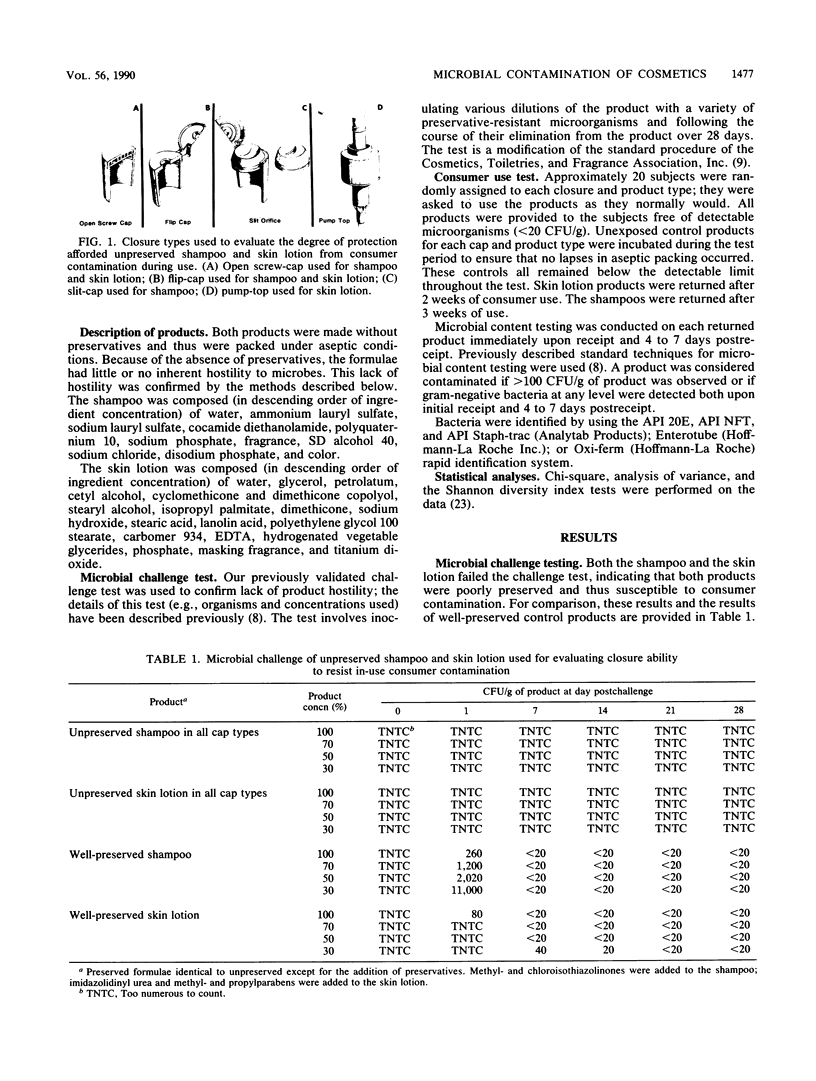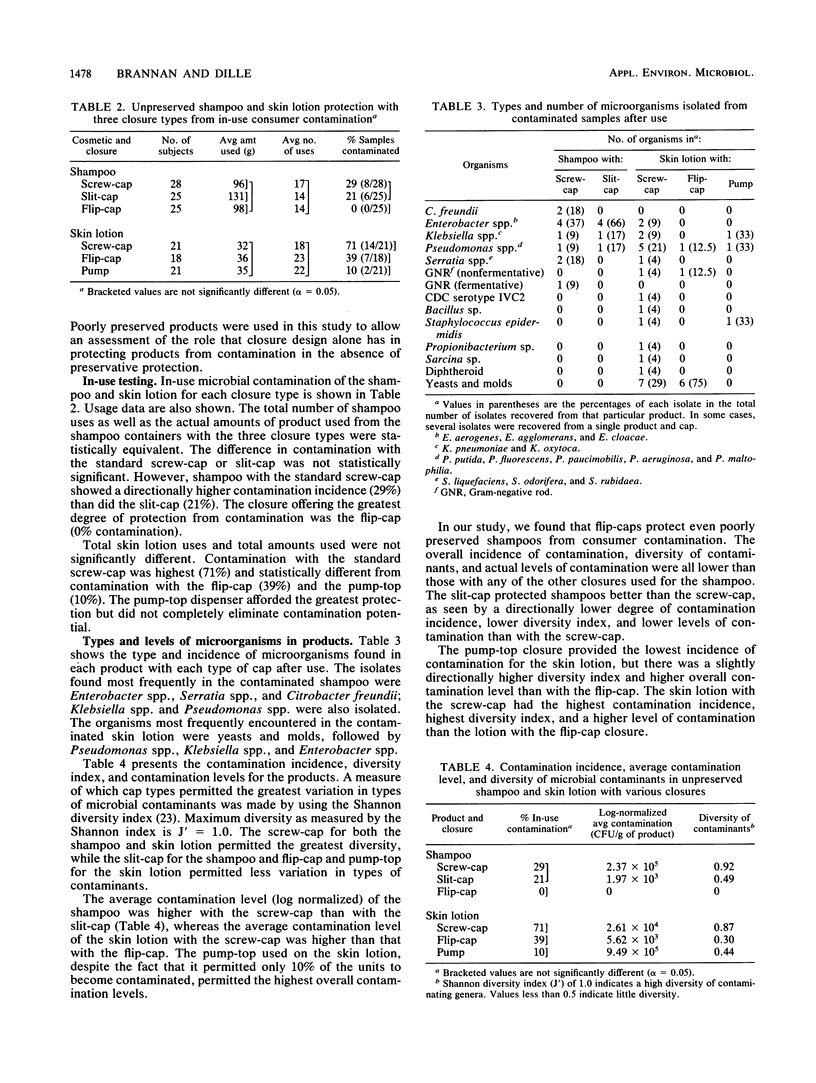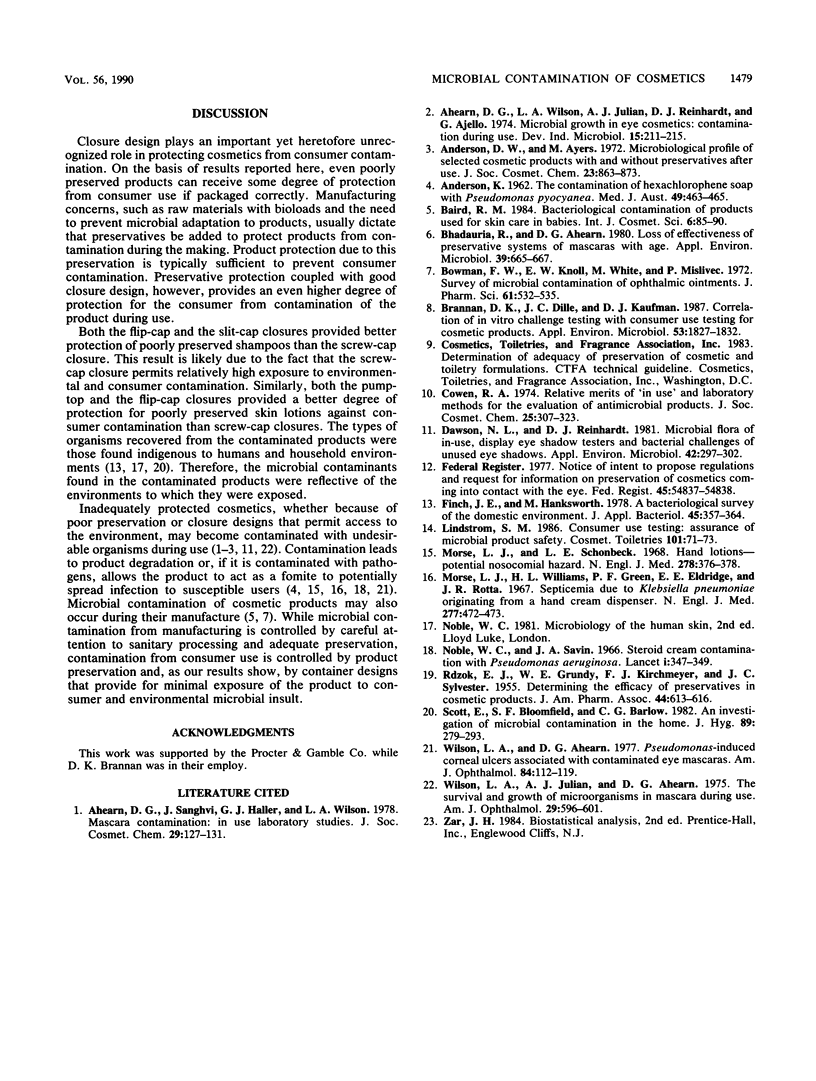Abstract
The dispensing closure used for containers plays an important role in protecting cosmetics from in-use microbial contamination. This hypothesis was tested by aseptically packing unpreserved shampoo and skin lotion into containers with three different closure types which provided various degrees of protection against consumer and environmental microbial insults. Shampoo was packed in containers with slit-cap (n = 25), flip-cap (n = 25), or screw-cap (n = 28) closures. Skin lotion was packed in containers with pump-top (n = 21), flip-cap (n = 18), or screw-cap (n = 21) closures. The products were then used by volunteers under actual in-use conditions for 3 (shampoo) or 2 (skin lotion) weeks. After use, the products were evaluated for microbial contamination by using standard methods for enumeration and identification. The standard screw-cap closure provided only minimal protection against microbial contamination of both the shampoo (29% contamination incidence) and the skin lotion (71%). The slit-cap closure on the shampoo container and the flip-cap closure on the skin lotion container provided slightly enhanced degrees of protection (21 and 39% contamination incidence, respectively). The greatest amount of protection (i.e., lowest contamination incidence) was provided by the flip-cap closure for the shampoo container (0%) and the pump-top closure for the skin lotion container (10%). As a result, closure type plays an important role in protecting poorly preserved products from in-use microbial contamination.
Full text
PDF



Images in this article
Selected References
These references are in PubMed. This may not be the complete list of references from this article.
- ANDERSON K. The contamination of hexachlorophene soap with Pseudomonas pyocyanea. Med J Aust. 1962 Sep 22;49(2):463–465. doi: 10.5694/j.1326-5377.1962.tb20451.x. [DOI] [PubMed] [Google Scholar]
- Bhadauria R., Ahearn D. G. Loss of effectiveness of preservative systems of mascaras with age. Appl Environ Microbiol. 1980 Mar;39(3):665–667. doi: 10.1128/aem.39.3.665-667.1980. [DOI] [PMC free article] [PubMed] [Google Scholar]
- Bowman F. W., Knoll E. W., White M., Mislivec P. Survey of microbial contamination of ophthalmic ointments. J Pharm Sci. 1972 Apr;61(4):532–535. doi: 10.1002/jps.2600610407. [DOI] [PubMed] [Google Scholar]
- Brannan D. K., Dille J. C., Kaufman D. J. Correlation of in vitro challenge testing with consumer use testing for cosmetic products. Appl Environ Microbiol. 1987 Aug;53(8):1827–1832. doi: 10.1128/aem.53.8.1827-1832.1987. [DOI] [PMC free article] [PubMed] [Google Scholar]
- Dawson N. L., Reinhardt D. J. Microbial flora of in-use, display eye shadow testers and bacterial challenges of unused eye shadows. Appl Environ Microbiol. 1981 Aug;42(2):297–302. doi: 10.1128/aem.42.2.297-302.1981. [DOI] [PMC free article] [PubMed] [Google Scholar]
- Finch J. E., Prince J., Hawksworth M. A bacteriological survey of the domestic environment. J Appl Bacteriol. 1978 Dec;45(3):357–364. doi: 10.1111/j.1365-2672.1978.tb04236.x. [DOI] [PubMed] [Google Scholar]
- Morse L. J., Schonbeck L. E. Hand lotions--a potential nosocomial hazad. N Engl J Med. 1968 Feb 15;278(7):376–378. doi: 10.1056/NEJM196802152780706. [DOI] [PubMed] [Google Scholar]
- Morse L. J., Williams H. L., Grenn F. P., Jr, Eldridge E. E., Rotta J. R. Septicemia due to Klebsiella pneumoniae originating from a hand-cream dispenser. N Engl J Med. 1967 Aug 31;277(9):472–473. doi: 10.1056/NEJM196708312770906. [DOI] [PubMed] [Google Scholar]
- Noble W. C., Savin J. A. Steroid cream contaminated with Pseudomonas aeruginosa. Lancet. 1966 Feb 12;1(7433):347–349. doi: 10.1016/s0140-6736(66)91325-0. [DOI] [PubMed] [Google Scholar]
- RDZOK E. J., GRUNDY W. E., KIRCHMEYER F. J., SYLVESTER J. C. Determining the efficacy of preservatives in pharmaceutical products. J Am Pharm Assoc Am Pharm Assoc. 1955 Oct;44(10):613–616. doi: 10.1002/jps.3030441011. [DOI] [PubMed] [Google Scholar]
- Scott E., Bloomfield S. F., Barlow C. G. An investigation of microbial contamination in the home. J Hyg (Lond) 1982 Oct;89(2):279–293. doi: 10.1017/s0022172400070819. [DOI] [PMC free article] [PubMed] [Google Scholar]
- Wilson L. A., Ahearn D. G. Pseudomonas-induced corneal ulcers associated with contaminated eye mascaras. Am J Ophthalmol. 1977 Jul;84(1):112–119. doi: 10.1016/0002-9394(77)90334-8. [DOI] [PubMed] [Google Scholar]
- Wilson L. A., Julian A. J., Ahearn D. G. The survival and growth of microorganisms in mascara during use. Am J Ophthalmol. 1975 Apr;79(4):596–601. doi: 10.1016/0002-9394(75)90798-9. [DOI] [PubMed] [Google Scholar]



